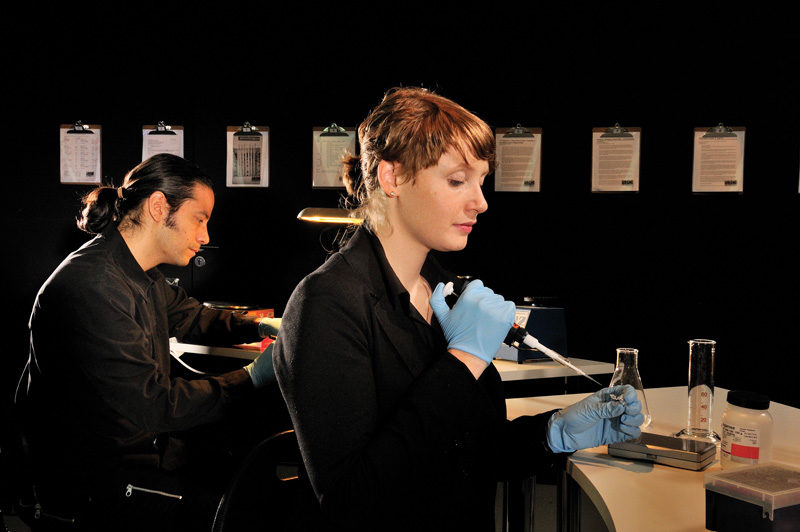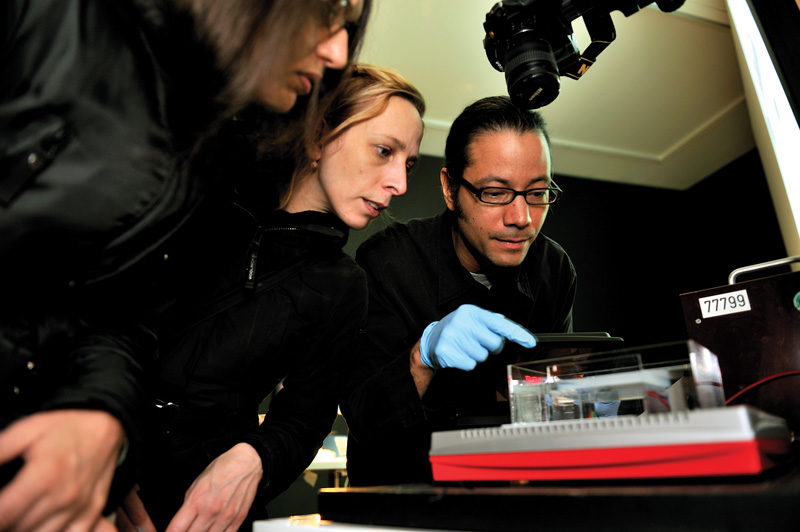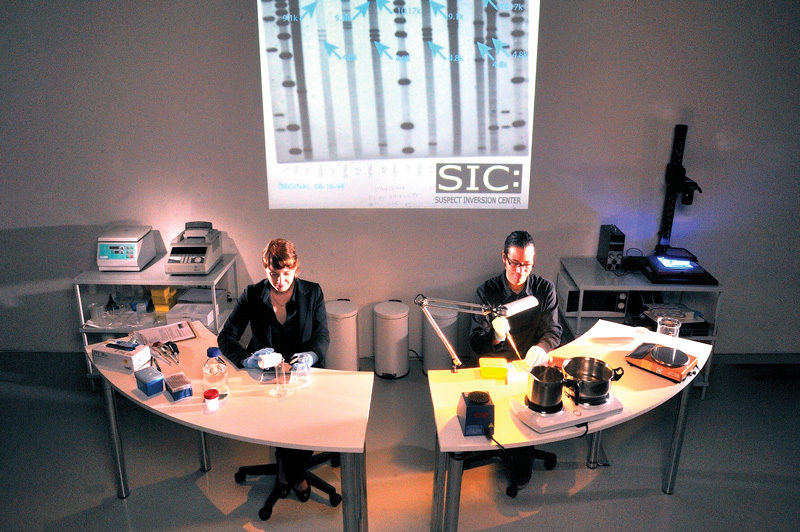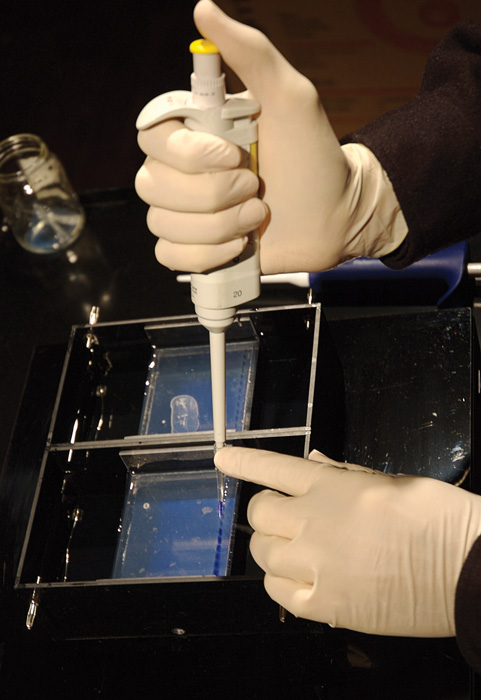[Winter 2013]
The American artist Paul Vanouse, known for his collaboration with the collective Critical Art Ensemble, has had a practice involving diversion since the early 1990s. He appropriates techniques, tools, materials1 , and knowledge from the techno-sciences in order to better examine what is at stake in those disciplines. His most recent productions, Relative Velocity Inscription Device (2002), Latent Figure Protocol (2007–10), and Ocular Revision (2010), emerged from his research on genetics and a series of experiments that he conducted. These works challenge the discourses and representations of DNA, notably in relation to the ethics of intellectual property and eugenics. His most recent project, the performance-installation Suspect Inversion Center (SIC), presented in 2011 at the Ernst Schering Foundation in Berlin, continues this inquiry, anchoring it specifically in the imaginary of the medico-legal investigation.
SIC transforms the exhibition space into an operational laboratory in which Vanouse and his assistant, Kerry Sheehan, perform various manipulations that reproduce “historically important DNA artefacts.”<sup>2</sup> Going beyond creation of a simple stage set mimicking science, the artist– a scholarly figure – has gathered knowledge and learned techniques needed to perform actual genomics procedures. The transposition of one universe into another, a subversive act in itself, instigates a transition from science to art and opens the closed space of the laboratory to the public. Taking on the role of mediator, Vanouse demands that science be more transparent while encouraging viewers to acquire a conscience and engage in critical thinking with regard to what it is “given to see.”
The artefacts that Vanouse tries to reproduce using his own DNA, as viewers look on curiously, are images of DNA profiles used as evidence during the famous trial of O. J. Simpson.3 During these court proceedings, perhaps the most intensely covered by the media ever, a huge amount of DNA evidence was presented against the defendant. The jury nevertheless decided to reject its probative value. Doubt had been raised due to accusations of racism against the investigators, who may have tampered with the evidence. In Vanouse’s view, this trial, which took place in the 1990s, marked a turning point in the conception of DNA in the collective imagination: it was the moment when the general public saw for the first time, within the social sphere, the potential power – the omnipotence – of DNA revealed.4 The scientific jargon used by witnesses during the trial, combined with the highly melodramatic atmosphere, did not, however, provide the public with an opportunity to truly understand the scientific techniques used.
Vanouse perhaps demonstrates a breach in the legal system opened by the attempt to grant the status of irrefutable evidence to DNA. Whether its use is purely scientific or is appropriated or diverted to other purposes, this technique is never equivalent to associating biological material or DNA with a single individual; it reveals only certain correspondence probabilities.
Suspect Inversion Center is thus highly didactic, offering visitors the opportunity to see in situ and understand in detail the creation of “genetic fingerprinting.” Over a period of weeks, the banding pattern typical of electrophoresis5 gradually appears. This simulacrum of the original images – resulting from the genetic profiles of Simpson and his alleged victims – is always tinkered together, constructed by Vanouse from his own biological data.6 For him, the final result is not as important as are the process and the questions raised by this performative act: “Every time a DNA band is not where we expect, or a ‘ghost’ band is inconvenient, we will have to confront what is ‘acceptable’ deviation of experimental evidence and how to overcome the apparent obstacle.”7 The potential malleability of genetic evidence in forensics has been raised by a number of authors. Their articles are placed in the exhibition space and available to visitors, allowing them to further their knowledge and develop their critical sense through other points of view.
By exhibiting the process of image reconstruction in this public laboratory, Vanouse hopes to challenge the use of the term “genetic fingerprint,” commonly used to designate this type of profiling in the context of medico-legal investigations. In fact, the term “fingerprint” conveys the idea of contact – a direct link to the source. It is also a metaphor for uniqueness and individuality. The fingerprint is a sign not of probability but of certainty – an insistent reminder of physicality.8 The term evokes, first of all, a trace left at the scene of a crime, a criminal investigation, but also the truth that it makes it possible to reveal.9 Even though DNA fingerprinting is “a statistically reasonable – but not infallible – method of identification,”10 it is linked to the fingerprint in order to suggest that it has the same quality of uniqueness. The use of fingerprints in forensics, for instance, certifies that a specific body was at a specific place, or in contact with a very specific object. In the legal concept, stating the probability of genetic fingerprinting rather than the certainty evoked by the fingerprint refers to assertion of law by probability.11 Vanouse perhaps demonstrates a breach in the legal system opened by the attempt to grant the status of irrefutable evidence to DNA. Whether its use is purely scientific or is appropriated or diverted to other purposes, this technique is never equivalent to associating biological material or DNA with a single individual; it reveals only certain correspondence probabilities. Yet what forensics techniques sell is the power to “read what is hidden from what is invisible.”12 The truth and the guilty party’s identity will be made visible by appropriate interpretation of the traces. The evidence is made visible by the image, as if the image were equal to a fact.
The title of Vanouse’s work, SIC – an anagram of the name of the popular tv series csi (Crime Scene Investigation) – refers to stories featuring forensics, a genre that is proliferating on network television and that perpetuates the mythology of the “genetic fingerprint” by conveying erroneous conceptions of scientific procedures. Unlike traditional investigation stories in which a puzzle was reconstructed from a bits from a story that led to finding the suspect, these science-flavoured stories take up the idea of revealing the physical link between the action, the moves made, and the guilty party13 – linking the evidence to its source, and finding the corresponding profile. The laboratory makes it possible to transform the “mystery” into “science,” with DNA creating the contiguity with the person responsible for the crime. This conception is also linked to representations of DNA in the collective imagination: the molecule is depicted either as the synecdoche for human identity or as a simple code to be deciphered in order to reveal the essence of an individual.
These popular scientific stories obviously don’t show the entire process of DNA extraction or electrophoresis. By playing with temporality, coupled with the efficiency of computer processing, identification is reduced to the coordination of various technologies and seems both magical and instantaneous. The computer is asked a question and, with no time to process or analyze the data, an answer is given.14 According to Judith Roof, viewers find the pseudoscience shown in these stories reassuring and seductive. Eschewing any uncertainty, this mastery of DNA gives the false impression of both total knowledge and a science that finally offers answers to questions about human identity. And, like these fictional accounts, forensics seeks to mask errors or insufficiencies in its techniques, generally preferring the illusion of a fluid, seamless process. If the product of such processes is to be used in a legal context as incontestable proof, it’s better to have a public that believes in the omnipotence of these technologies.15
Suspect Inversion Center is thus presented as the inversion of the strategies deployed by technological fictions of forensics stories. SIC creates “skepticism and total demystification”:16 the artwork exposes the creation of DNA imagery in the public sphere, links the image to its procedure, shows how long these scientific procedures really take, and provides access to all aspects of lab work, the intermediary documents of which have served in one or another of the research steps. The work invites viewers to become aware of the inter-influence and porosity of the cultural sphere, the imagination, science, and technologies. In Vanouse’s view, transparency may, in the end, be the path that will lead viewers toward truly critical thought.
Translated by Käthe Roth
2 Paul Vanouse, “Counter Laboratories, Inverted Suspects and Latent Sings,” in Jens Hauser (ed.), Paul Vanouse: Fingerprints . . . Index – Imprint – Trace (Berlin: Argobooks, 2011), p. 53.
3 The American football star was accused of killing his ex-wife, Nicole Brown Simpson, and her friend Ronald Goldman; the trial took place in 1994–95.
4 Vanouse, “Counter Laboratories,” p. 49.
5 Electrophoresis is a molecular biology technique that uses electricity toseparate molecules by size. In this case the process is gel electrophoresis – that is,an electric current is applied to the molecules, causing them to migrate through agel matrix.
6 Jens Hauser, “Fingerprints . . . Naturally Technical,” in Jens Hauser (ed.), Paul Vanouse: Fingerprints . . . Index – Imprint – Trace (Berlin: Argobooks, 2011), p. 13.
7 Vanouse, “Counter Laboratories,” p. 55.
8 Judith Roof, The Poetics of DNA (Minneapolis: University of Minnesota Press, 2007), p. 187. 9 Simon A. Cole,“Fingerprints: The Trace of Race, in Jans Hauser (ed.), Paul Vanouse: Fingerprints . . . Index – Imprint – Trace (Berlin: Argobooks, 2011), p. 69. 10 Dorothy Nelkin and Susan Lindee, The DNA Mystique: The Gene as a Cultural Icon (Ann Arbor: University
of Michigan Press, 2004), p. 47.
11 Roof, Poetics of DNA, p. 187.
12 Cole, “Fingerprints,” p. 71.
13 Roof, Poetics of DNA, p. 191.
14 Ibid., p. 193.
15 Ibid., p. 194.
16 Vanouse, “Counter Laboratories,” p. 65.
Marianne Cloutier is a doctoral student and lecturer in the Department of Art History at UQAM. Her research deals mainly with representations of the body and identity-related questions in contemporary art practices using biotechnologies.
Since the early 1990s, Paul Vanouse’s artwork has addressed complex issues raised by varied new techno-sciences using these very techno-sciences as a medium. His artworks have included data-collection devices that examine the ramifications of sample surveys and categorization, genetic experiments that undermine scientific constructions of race and identity, and temporary organizations that playfully critique institutionalization and corporatization. His electronic cinema, biological experiments, and interactive installations have been exhibited in over twenty countries and widely across the us. His recent projects, Latent Figure Protocol, Ocular Revision and Suspect Inversion Center use molecular biology techniques to challenge “genome-hype” and to confront issues surrounding DNA fingerprinting. Vanouse is a professor of visual studies at the University at Buffalo, n.y. He holds a bfa from the University at Buffalo (1990) and an mfa from Carnegie Mellon University (1996). paulvanouse.com






